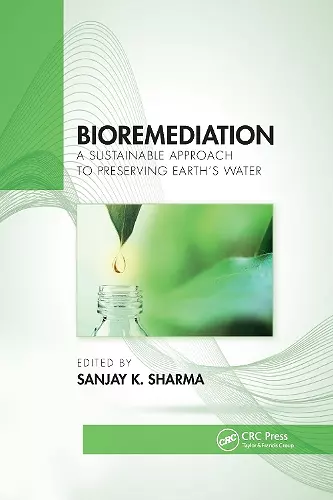Bioremediation
A Sustainable Approach to Preserving Earth’s Water
Format:Paperback
Publisher:Taylor & Francis Ltd
Published:30th Sep '21
Currently unavailable, and unfortunately no date known when it will be back
This paperback is available in another edition too:
- Hardback£180.00(9781138593077)

Bioremediation: A Sustainable Approach to Preserving Earth’s Water discusses the latest research in green chemistry practices and principles that are involved in water remediation and the quality improvement of water.
The presence of heavy metals, dyes, fluoride, dissolved solids and many other pollutants are responsible for water pollution and poor water quality. The removal of these pollutants in water resources is necessary, yet challenging. Water preservation is of great importance globally and researchers are making significant progress in ensuring this precious commodity is safe and potable. This volume illustrates how bioremediation in particular is a promising green technique globally.
Features:
- Addresses bioremediation of all the major water pollutants
- Approaches the chemistry of water and the concept of water as a renewable resource from a green chemistry aspect
- Discusses environmental chemistry and the practice of industrial ecology
- Explains the global concern of adequate high quality water supplies, and how bioremediation can resolve this
- Explores sustainable development through green engineering
Processing of water is a major activity that affects health and safety in all countries of the world. While many water treatment processes have a long history of development and improvement, there is continuing progress both in terms of remediating new chemicals found in effluents and through ongoing laboratory research. The ten chapters in this book address varied subjects such as green chemistry in water processing, biofunctionalized adsorbents, biodegradation and adsorption of dyes, synthesis of adsorbents, olive oil waste treatment, and processing of industrial effluents. Notably, more than five thousand publications related to remediation of water have been gathered in a bibliometric study; the results are presented in chapter 2. Chapter 4 covers adsorption of heavy metals and includes information on many equilibrium isotherms. Bioremediation of industrial contaminants found in soil as well as industrial effluents are discussed in chapter 8. This chapter includes tables of effective microorganisms for biodegradation of different industrial wastes. All chapters, indeed, provide numerous citations and references as well as helpful tables and figures. Contributing authors hail from many different countries including Brazil, Colombia, India, Indonesia, Portugal, and Turkey. This collection will be especially useful for scholars and civil engineers concerned with preserving water resources through remediation.
--L. E. Erickson, emeritus, Kansas State University, Choice Reviews and Highly Recommended
Summing Up: Highly recommended. All readers.
Processing of water is a major activity that affects health and safety in all countries of the world. While many water treatment processes have a long history of development and improvement, there is continuing progress both in terms of remediating new chemicals found in effluents and through ongoing laboratory research. The ten chapters in this book address varied subjects such as green chemistry in water processing, biofunctionalized adsorbents, biodegradation and adsorption of dyes, synthesis of adsorbents, olive oil waste treatment, and processing of industrial effluents. Notably, more than five thousand publications related to remediation of water have been gathered in a bibliometric study; the results are presented in chapter 2. Chapter 4 covers adsorption of heavy metals and includes information on many equilibrium isotherms. Bioremediation of industrial contaminants found in soil as well as industrial effluents are discussed in chapter 8. This chapter includes tables of effective microorganisms for biodegradation of different industrial wastes. All chapters, indeed, provide numerous citations and references as well as helpful tables and figures. Contributing authors hail from many different countries including Brazil, Colombia, India, Indonesia, Portugal, and Turkey. This collection will be especially useful for scholars and civil engineers concerned with preserving water resources through remediation.
--L. E. Erickson, emeritus, Kansas State University, Choice Reviews and Highly Recommended
Summing Up: Highly recommended. All readers.
ISBN: 9781032176796
Dimensions: unknown
Weight: 390g
280 pages